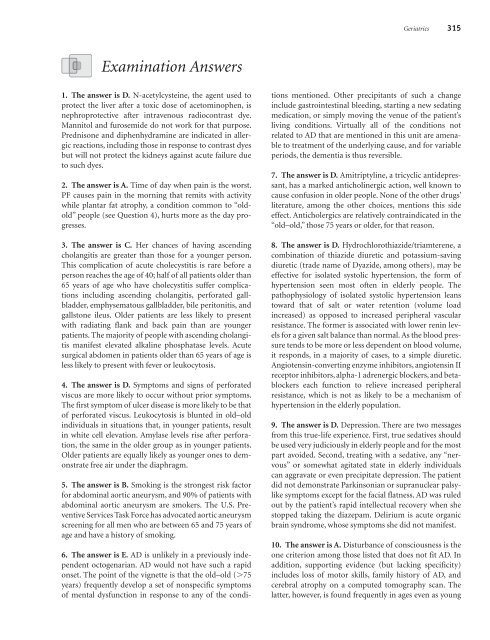NMS Q&A Family Medicine
NMS Q&A Family Medicine
NMS Q&A Family Medicine
- No tags were found...
Create successful ePaper yourself
Turn your PDF publications into a flip-book with our unique Google optimized e-Paper software.
Geriatrics 315Examination Answers1. The answer is D. N-acetylcysteine, the agent used toprotect the liver after a toxic dose of acetominophen, isnephroprotective after intravenous radiocontrast dye.Mannitol and furosemide do not work for that purpose.Prednisone and diphenhydramine are indicated in allergicreactions, including those in response to contrast dyesbut will not protect the kidneys against acute failure dueto such dyes.2. The answer is A. Time of day when pain is the worst.PF causes pain in the morning that remits with activitywhile plantar fat atrophy, a condition common to “oldold”people (see Question 4), hurts more as the day progresses.3. The answer is C. Her chances of having ascendingcholangitis are greater than those for a younger person.This complication of acute cholecystitis is rare before aperson reaches the age of 40; half of all patients older than65 years of age who have cholecystitis suffer complicationsincluding ascending cholangitis, perforated gallbladder,emphysematous gallbladder, bile peritonitis, andgallstone ileus. Older patients are less likely to presentwith radiating flank and back pain than are youngerpatients. The majority of people with ascending cholangitismanifest elevated alkaline phosphatase levels. Acutesurgical abdomen in patients older than 65 years of age isless likely to present with fever or leukocytosis.4. The answer is D. Symptoms and signs of perforatedviscus are more likely to occur without prior symptoms.The first symptom of ulcer disease is more likely to be thatof perforated viscus. Leukocytosis is blunted in old–oldindividuals in situations that, in younger patients, resultin white cell elevation. Amylase levels rise after perforation,the same in the older group as in younger patients.Older patients are equally likely as younger ones to demonstratefree air under the diaphragm.5. The answer is B. Smoking is the strongest risk factorfor abdominal aortic aneurysm, and 90% of patients withabdominal aortic aneurysm are smokers. The U.S. PreventiveServices Task Force has advocated aortic aneurysmscreening for all men who are between 65 and 75 years ofage and have a history of smoking.6. The answer is E. AD is unlikely in a previously independentoctogenarian. AD would not have such a rapidonset. The point of the vignette is that the old–old (75years) frequently develop a set of nonspecific symptomsof mental dysfunction in response to any of the conditionsmentioned. Other precipitants of such a changeinclude gastrointestinal bleeding, starting a new sedatingmedication, or simply moving the venue of the patient’sliving conditions. Virtually all of the conditions notrelated to AD that are mentioned in this unit are amenableto treatment of the underlying cause, and for variableperiods, the dementia is thus reversible.7. The answer is D. Amitriptyline, a tricyclic antidepressant,has a marked anticholinergic action, well known tocause confusion in older people. None of the other drugs’literature, among the other choices, mentions this sideeffect. Anticholergics are relatively contraindicated in the“old–old,” those 75 years or older, for that reason.8. The answer is D. Hydrochlorothiazide/triamterene, acombination of thiazide diuretic and potassium-savingdiuretic (trade name of Dyazide, among others), may beeffective for isolated systolic hypertension, the form ofhypertension seen most often in elderly people. Thepathophysiology of isolated systolic hypertension leanstoward that of salt or water retention (volume loadincreased) as opposed to increased peripheral vascularresistance. The former is associated with lower renin levelsfor a given salt balance than normal. As the blood pressuretends to be more or less dependent on blood volume,it responds, in a majority of cases, to a simple diuretic.Angiotensin-converting enzyme inhibitors, angiotensin IIreceptor inhibitors, alpha-1 adrenergic blockers, and betablockerseach function to relieve increased peripheralresistance, which is not as likely to be a mechanism ofhypertension in the elderly population.9. The answer is D. Depression. There are two messagesfrom this true-life experience. First, true sedatives shouldbe used very judiciously in elderly people and for the mostpart avoided. Second, treating with a sedative, any “nervous”or somewhat agitated state in elderly individualscan aggravate or even precipitate depression. The patientdid not demonstrate Parkinsonian or supranuclear palsylikesymptoms except for the facial flatness. AD was ruledout by the patient’s rapid intellectual recovery when shestopped taking the diazepam. Delirium is acute organicbrain syndrome, whose symptoms she did not manifest.10. The answer is A. Disturbance of consciousness is theone criterion among those listed that does not fit AD. Inaddition, supporting evidence (but lacking specificity)includes loss of motor skills, family history of AD, andcerebral atrophy on a computed tomography scan. Thelatter, however, is found frequently in ages even as young
















